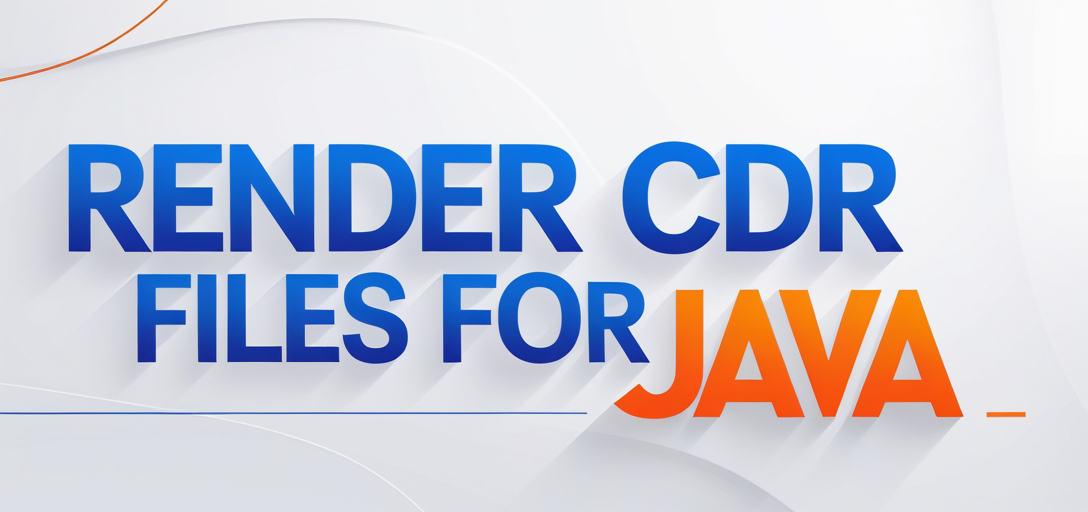Render CDR Files with GroupDocs.Viewer Java: Complete Guide to HTML, JPG, PNG, and PDF Conversion
Welcome to this detailed guide on rendering CorelDRAW (CDR) documents into various formats like HTML, JPG, PNG, and PDF using GroupDocs.Viewer for Java. If you’re dealing with graphic files and need a seamless way to convert them across platforms, this tutorial is your go-to resource.

What You’ll Learn:
- How to set up GroupDocs.Viewer in your Java environment
- Step-by-step implementation of rendering CDR documents into HTML, JPG, PNG, and PDF formats
- Practical applications for these conversions
- Performance optimization tips
Let’s dive right into the prerequisites before we start implementing!
Prerequisites
Before you begin, ensure that you have the following:
- Libraries and Dependencies: Set up GroupDocs.Viewer in your Java project.
- Environment Setup: Ensure your development environment is ready for Java applications.
- Basic Java Knowledge: Familiarity with basic Java programming concepts will be beneficial.
Required Libraries, Versions, and Dependencies
To get started with GroupDocs.Viewer, add the following Maven dependency to your pom.xml:
<repositories>
<repository>
<id>repository.groupdocs.com</id>
<name>GroupDocs Repository</name>
<url>https://releases.groupdocs.com/viewer/java/</url>
</repository>
</repositories>
<dependencies>
<dependency>
<groupId>com.groupdocs</groupId>
<artifactId>groupdocs-viewer</artifactId>
<version>25.2</version>
</dependency>
</dependencies>
Environment Setup Requirements
Ensure that you have the Java Development Kit (JDK) installed and set up on your machine. Your IDE should be configured to handle Maven projects.
License Acquisition Steps
GroupDocs.Viewer offers a free trial, temporary licenses for testing purposes, or purchase options for long-term use. Follow these steps:
- Free Trial: Download the library from GroupDocs Release Page.
- Temporary License: Request one at GroupDocs Temporary License Page.
- Purchase: Buy a license through the GroupDocs Purchase Page.
Setting Up GroupDocs.Viewer for Java
Installation with Maven
To integrate GroupDocs.Viewer into your project, add the above dependency to your pom.xml. This will automatically handle downloading and setting up the necessary libraries.
License Initialization
Once downloaded or purchased, initialize your license as follows:
import com.groupdocs.viewer.License;
License lic = new License();
lic.setLicense("path/to/your/license/file.lic");
Implementation Guide
Now, let’s explore how to render CDR documents into different formats using GroupDocs.Viewer.
Rendering CDR Document to HTML
Overview: Convert your CDR files into web-friendly HTML format for easy sharing and viewing.
Step-by-Step Guide:
Set Up File Paths
Define the output directory where the converted HTML files will be saved.
import java.nio.file.Path; Path outputDirectory = TestFiles.getOutputDirectoryPath("RenderingCdr"); Path pageFilePathFormat = outputDirectory.resolve("cdr_result_{0}.html");Initialize Viewer
Create a
Viewerinstance for your CDR file.import com.groupdocs.viewer.Viewer; try (Viewer viewer = new Viewer(TestFiles.SAMPLE_CDR)) { HtmlViewOptions options = HtmlViewOptions.forEmbeddedResources(pageFilePathFormat); viewer.view(options); // Render the document into HTML format }
Explanation:
HtmlViewOptions: This class is used to configure HTML rendering settings, such as embedding resources directly within the HTML file.- Parameters: The page file path format helps in naming your output files systematically.
Rendering CDR Document to JPG
Overview: Convert CDR documents into high-quality JPEG images for easy distribution and viewing.
Step-by-Step Guide:
Set Up File Paths
Define where the JPEG files will be stored.
Path pageFilePathFormat = outputDirectory.resolve("cdr_result_{0}.jpg");Initialize Viewer and Render
Use
JpgViewOptionsto render your document into JPG format.import com.groupdocs.viewer.options.JpgViewOptions; try (Viewer viewer = new Viewer(TestFiles.SAMPLE_CDR)) { JpgViewOptions options = new JpgViewOptions(pageFilePathFormat); viewer.view(options); // Render the document into JPG format }
Explanation:
- JpgViewOptions: Configures JPEG-specific settings, such as quality and resolution.
Rendering CDR Document to PNG
Overview: Convert your CDR files into PNG images for high-quality outputs with lossless compression.
Step-by-Step Guide:
Set Up File Paths
Define the output path for PNG files.
Path pageFilePathFormat = outputDirectory.resolve("cdr_result_{0}.png");Initialize Viewer and Render
Use
PngViewOptionsto render into PNG format.import com.groupdocs.viewer.options.PngViewOptions; try (Viewer viewer = new Viewer(TestFiles.SAMPLE_CDR)) { PngViewOptions options = new PngViewOptions(pageFilePathFormat); viewer.view(options); // Render the document into PNG format }
Explanation:
- PngViewOptions: Allows you to specify settings like color depth and compression.
Rendering CDR Document to PDF
Overview: Convert your CDR files into universally accessible PDF documents.
Step-by-Step Guide:
Set Up File Paths
Define where the PDF file will be stored.
Path pageFilePathFormat = outputDirectory.resolve("cdr_result.pdf");Initialize Viewer and Render
Use
PdfViewOptionsto render into PDF format.import com.groupdocs.viewer.options.PdfViewOptions; try (Viewer viewer = new Viewer(TestFiles.SAMPLE_CDR)) { PdfViewOptions options = new PdfViewOptions(pageFilePathFormat); viewer.view(options); // Render the document into PDF format }
Explanation:
- PdfViewOptions: Configures settings specific to PDF rendering, such as encryption and permissions.
Practical Applications
- Web Portals: Use HTML conversion for displaying CDR files directly on websites.
- Image Galleries: Render JPG/PNG versions for image-based galleries or portfolios.
- Document Sharing Platforms: Utilize PDF conversions for easy document distribution.
- Archiving Systems: Maintain different formats for archival purposes, ensuring compatibility across systems.
- Cross-Platform Applications: Integrate with other applications that support these formats to enhance functionality.
Performance Considerations
When working with GroupDocs.Viewer, consider the following:
- Optimize Memory Usage: Ensure efficient memory management by disposing of resources after use.
- Batch Processing: Process documents in batches to reduce load times and optimize performance.
- Resource Allocation: Allocate sufficient CPU and RAM for processing large files.
Conclusion
In this tutorial, we’ve covered how to render CDR documents into HTML, JPG, PNG, and PDF formats using GroupDocs.Viewer for Java. By following these steps, you can effectively convert your graphic files across different platforms, enhancing accessibility and usability.
Next Steps:
- Experiment with advanced rendering options.
- Explore integration possibilities with other systems or applications.
- Share feedback or ask questions in the GroupDocs Forum.